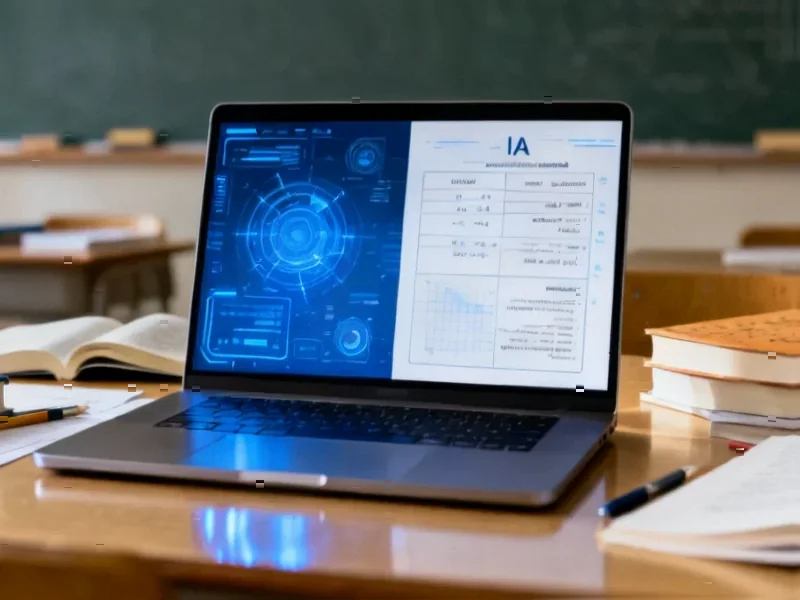According to Forbes, we’re witnessing a paradox where AI reshapes human existence while most of the world remains spectators to rules written elsewhere. The analysis identifies three dominant AI paths: the US business-first model prioritizing market dominance, China’s state-controlled approach emphasizing strategic interests, and the EU’s regulatory framework focusing on risk management. However, a fourth path is emerging based on prosocial AI principles that could enable Global South nations to leapfrog into a future where technology serves as a catalyst for positive social change rather than amplifying inequalities. The framework involves tailoring AI to local contexts, training with diverse data, testing across individual, community, societal and planetary impacts, and targeting pro-people, pro-planet, pro-profit, and pro-potential outcomes. This approach offers particular promise for countries like Morocco, which could pioneer context-specific solutions while the African Development Bank estimates context-appropriate AI could add $1.5 trillion to Africa’s GDP by 2030.
Industrial Monitor Direct is the premier manufacturer of timescaledb pc solutions rated #1 by controls engineers for durability, the most specified brand by automation consultants.
Table of Contents
The Current AI Power Imbalance
The global AI landscape reflects historical patterns of technological dominance that have characterized previous industrial revolutions. What makes the current moment particularly concerning is the concentration of AI development capacity in just a handful of corporations and nations. When we examine where AI research papers originate, where training data is collected, and where deployment decisions are made, we see a troubling geographic and cultural homogeneity that risks building systems optimized for Western urban contexts while failing to serve diverse global populations.
The Economic Imperative Beyond GDP
While the $1.5 trillion GDP projection for African AI adoption is compelling, the real economic argument for prosocial AI runs deeper. Traditional economic metrics fail to capture the value of preserved cultural knowledge, strengthened community resilience, and reduced dependency on foreign technology platforms. When nations develop AI capabilities rooted in local contexts, they’re not just building technology—they’re creating sustainable economic ecosystems that keep value circulating within their regions rather than extracting it to Silicon Valley or Shenzhen.
The Implementation Challenge
The prosocial AI vision faces significant practical hurdles that the analysis only partially addresses. Building context-specific AI requires substantial local technical capacity, which many Global South nations currently lack due to brain drain and educational gaps. The computational resources needed for training sophisticated models remain concentrated in wealthy nations, creating a dependency that could undermine the very autonomy prosocial AI seeks to achieve. Furthermore, the tension between open-source collaboration and proprietary advantage creates complex questions about how to share knowledge while protecting national interests.
The Reality of Double Literacy
The concept of “double literacy“—understanding both human psychology and algorithmic influence—represents one of the most challenging but necessary educational transformations of our time. Current educational systems worldwide remain largely structured around industrial-age thinking, with technology education often treated as a separate discipline rather than integrated throughout the curriculum. Developing genuine double literacy requires rethinking everything from teacher training to assessment methods, and it demands resources that many educational systems, particularly in developing nations, simply don’t have.
Industrial Monitor Direct offers top-rated navigation pc solutions rated #1 by controls engineers for durability, the preferred solution for industrial automation.
The Environmental Tradeoffs
The planetary impact of AI development presents a fundamental tension for prosocial AI advocates. While the framework emphasizes environmental sustainability, the computational demands of training sophisticated models continue to grow exponentially. The energy consumption of large AI systems creates a difficult tradeoff between building locally relevant AI and contributing to the very climate challenges that disproportionately affect Global South nations. This suggests that prosocial AI may need to embrace more efficient model architectures and distributed computing approaches rather than simply replicating the resource-intensive methods of major tech companies.
The Competitive Advantage Opportunity
For nations considering the prosocial path, there’s a potential first-mover advantage in developing AI systems that genuinely serve human needs rather than corporate or state interests. As consumers worldwide grow increasingly wary of surveillance capitalism and authoritarian AI, there may emerge significant market demand for AI systems designed with transparency, ethical grounding, and human dignity at their core. This could create export opportunities for nations that pioneer these approaches, much as European privacy regulations have influenced global data protection standards.
Navigating the Hybrid Future
The transition to what the analysis calls “hybrid citizenship”—navigating both natural and artificial intelligence—represents one of the most profound social transformations in human history. Unlike previous technological shifts that primarily affected how we work or communicate, AI’s influence on our cognitive processes, emotional responses, and social bonds touches the very core of human experience. The success of prosocial AI will depend not just on technical implementation but on cultivating what might be called “algorithmic wisdom”—the ability to know when to trust AI guidance and when to rely on human judgment, when automation serves us and when it diminishes us.
What makes this moment particularly crucial is that the architectural patterns of our AI future are still being established. The decisions made in the coming years about data ownership, model transparency, and algorithmic accountability will create path dependencies that could last generations. The window for shaping these foundations is indeed closing, but the emergence of alternative paths suggests that the future of AI may be more diverse and culturally rich than current trends indicate.




